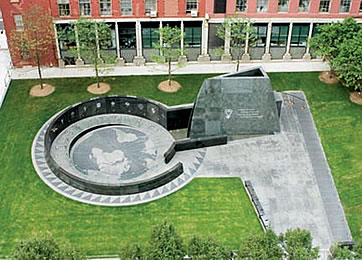
Courtesy of National Park Service
For a century, from the 1690s to the 1790s, a small plot of land in Lower Manhattan became the final resting place for over 15,000 free and enslaved Africans. The burial ground was then lost under years of urban development and landfill, until workers rediscovered the burial ground in 1991 during an excavation of the land for a Federal Government office building. Excavations at the site revealed the remains of 419 Africans and over 500 individual artifacts. Considered one of the most important archeological finds of the 20th century, the African Burial Ground is of national significance because of what it can tell us about the lives of Africans and African Americans in an urban context. Both the deceased and their possessions help piece together a more complete history of New York City in the 17th and 18th centuries and what life was like for Africans in the city. The discoveries demonstrate the power of collaboration between anthropology, archaeology, and history.
In the 1640s, the Dutch granted conditional freedom to a group of African men and women. This action would serve as the impetus for the creation of an African community in New York. Settling themselves outside of town, roughly a mile from the tip of Manhattan, the African community developed a distinct culture. In 1697, Africans were not allowed to bury their dead in what had become New York’s primary burial ground. Scholars believe that this ban was the reason Africans used the burial ground today recognized as the African Burial Ground National Monument. Forced to establish their own burial ground, Africans created their sacred space in what was at the time the “Commons” area away from the bustle of the city. Today the burial ground is in downtown Manhattan.
Little was known about the African community in New York in the 18th century until the discovery of the burial ground. This site provided anthropologists, archaeologists, and historians with new evidence about the funeral practices, nutrition, disease, physical stress, injury, and various occupations within the African community. These discoveries sparked considerable interdisciplinary research that led to the establishment of a visitor center and museum with persuasive exhibits that demonstrate the site’s contribution to history. This is by far the largest excavated African burial ground--by several hundred identifiable persons. Africans created their own sacred space that was unknown until accidentally discovered and investigated over two centuries later.
Howard University scholars led a collaborative team that conducted intense research including excavation of the site. This work resulted in three collaborative reports, that presents to African Burial Ground Final History Report, Final Skeletal Biology Report, and the Final Archaeology Report which are accessible by African Burial Ground National Monument in the Archaelology Report Webpage. These reports present historical, bioanthropological, and archaeological analyses of the artifacts found at the African Burial Ground.
Visitors will find both indoor and outdoor activities at the African Burial Ground National Monument. The visitor center has exhibits, replica artifacts, and a 25-minute video about the history of the site. A collection of commissioned commemorative artwork is also available for the public to view. National Park Service rangers provide interpretative educational programs. Outside the visitor center, for those looking to reflect, artist Rodney Leon’s memorial provides a tribute to the 15,000 people interred beneath Manhattan. In addition, 90-minute walking tours on the subject, “A Broader View: The African Presence in Early New York,” offer visitors information about the social, political, cultural, and economic aspects of African life in colonial New York City.
Recognizing the site’s importance, the Secretary of the Interior designated the African Burial Ground a National Historic Landmark in 1993, and it is listed in the National Register of Historic Places. In 2006, the African Burial Ground became a national monument administered by the National Park Service. The African Burial Ground evolved further with the dedication of Rodney Leon’s memorial in 2007, and the opening of the new visitor center in 2010. The African Burial Ground National Monument provides visitors with insights and important lessons about the roles and lives of free and enslaved Africans in colonial America.
African Burial Ground National Monument, a unit of the National Park System and a National Historic Landmark, is located in Lower Manhattan, close to Foley Square and just north of City Hall in New York City, NY. The visitor center is inside the Ted Weiss Federal Building at 290 Broadway. The memorial is located behind the Ted Weiss Federal Building at the corner of Duane Street and African Burial Ground Way (Elk St.) It was listed on the National Register of Historic Places on April 19, 1993 and designated as a National Historial Landmark in February 2006. For more information, visit the National Park Service African Burial Ground National Monument website or call 212-637-2019.
Last updated: August 18, 2017
